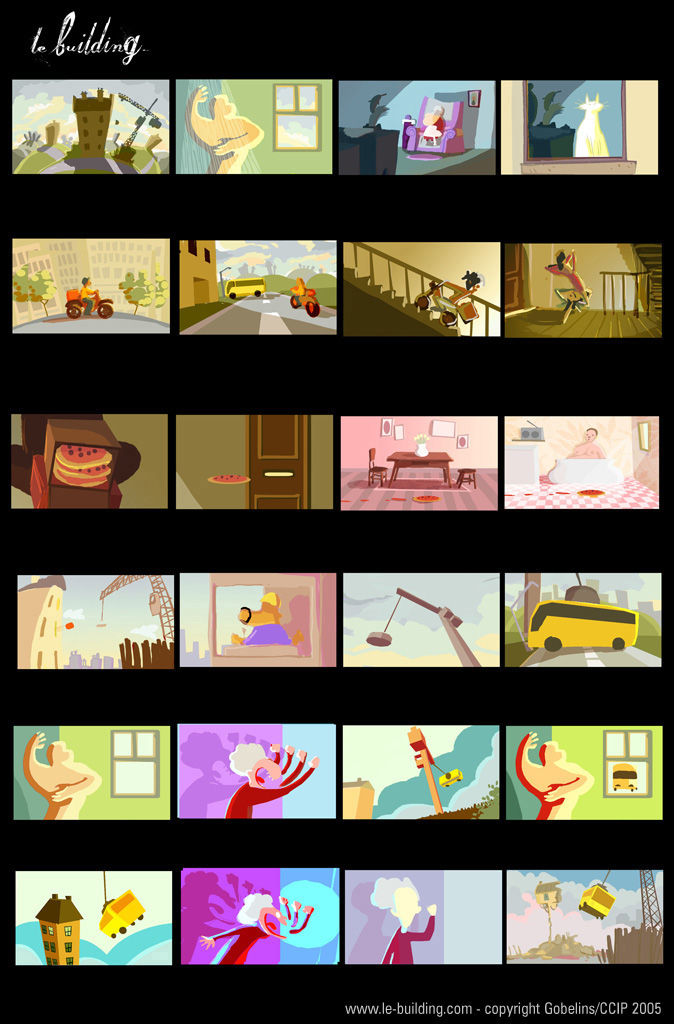Le Building
‘Le Building’ is a 2005 student film which earned an oscar nomination, created by a team of 5 french students; Olivier Staphylas, Marco Nguyen, Pierre Perifel, Xavier Ramonède and Rémi Zaarour from the animation school “the Gobelins” in Paris, France. If you are a fan of animation then you will probably have heard of ‘le Gobelins’ somewhere as it seems they are consistently churning out brilliant animations, and many of their alumni have gone on to work at major animation studios.
The movie was completed in 4 and a half months, including screenplay, storyboards and designs. The technique is a mix between traditional 2D, Flash, and 3D animation. With these differing techniques used, the challenge was to blend them so that the audience won’t notice it too much. For example the pizza guy, his bike, the bus, and the crane are in 3D. The cat on the pizza guy’s head is animated with Flash and the other characters are traditionally 2D animated. [1]
The video above shows some of the behind the scenes action to give an idea of what was necessary to bring this film to life. The 3D elements were toon-shaded to make them fit effectively into the cartoony hand-drawn style, and the filmmakers also ensured that the characters and even the vehicles had the ability to squash and stretch for exactly the same reason. The backgrounds are beautifully hand-painted and the story is succinct and to the point. Nothing is wasted in this short film, so the viewer is taken on this wild ride right from the get go.

The above image is the colourscript from le building. A colourscript provides a roadmap for shifts in colour, lighting, emotion and mood throughout a film.[2] It is a tool which helps the filmmakers to visualise the whole film and make changes to the hue, tone, saturation, etc of scenes. Once you have a completed storyboard you can begin to think about colour choices and it’s a good idea to create a colourscript so you can make changes before committing to animating the final scenes.
There is a lot to like about this film, and i really do like this film a lot. It’s a very cohesive piece of media, with a very solid flow to the story, culminating in a really satisfying ending. The comedy is on point and everything is really well done and looks professional – i mean of course it does its le gobelins! The choices they make for which software to use and how to make it appear consistent to the audience is diligently done and in the end it all looks like a very stylised world without the differences being incredibly noticeable – and this was made nearly 20 years ago.
But this is precisely how my film ‘Pizzaguy’ will differ from this example. I want my animation to celebrate the different styles of animation, and be almost jarringly obvious to the audience, while remaining a consistent piece of film. There are a number of things I considered when deciding how to go about this. The story needed to be simple. If the animation was going to change drastically and i was going to be able to take some risks and experiment with different mediums and softwares i needed the story to be straightforward and easy to follow. With my thesis film ‘Pinkguy’ the story was something the audience could read into and theorise things about, it was experimental with the narrative, whereas ‘Pizzaguy’ has to be quite linear. So i settled on the film being a chase. No matter where i took the action or what happened to the character along the way, the little slice of Pizza would always keep chasing, even if he may have forgotten why he was running, or where he was going, he was always going to be chasing from the start to the end.
I also wanted to add an element to the film which would make the changes in style make sense to the audience, at least initially. Using portals just made sense to me. The pizza could pass through these portals and change style and the audience would see that each ‘dimension’ he enters changes him slightly, while still knowing it is the same slice of pizza from the beginning of the movie. Then when i wanted to later, i could ramp it up so that from shot to shot the look and style of the film/character could alter and the audience would not be lost wondering why on earth this is happening.
By making the story easy to follow, and using narrative elements like the portal to explain why its happening, these small things will let the audience simply enjoy the film without losing interest because it doesn’t look consistent in the ways they are used to, or becoming too distracted. When I decided i wanted to make a hybrid animated short film i wanted to push it as far as i could and try lots of different styles and mediums, and i knew that i also wanted to challenge myself, while still having a finished film that wasn’t a total mishmash of confusion.
References
[1] http://www.le-building.com
[2] Amid Amidi author of “The Art of Pixar: 25th Anniv.: The Complete Color Scripts and Select Art from 25 Years of Animation”
